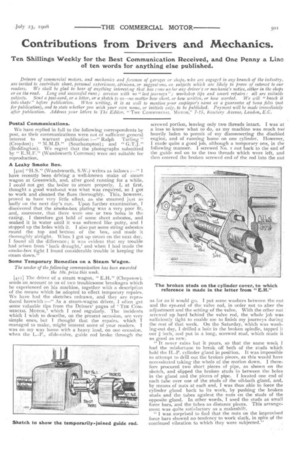Contributions from Drivers and Mechanics.
Page 19

If you've noticed an error in this article please click here to report it so we can fix it.
Ten Shillings Weekly for the Best Communication Received, and One Penny a Line of ten words for anything else published.
Drivers of commercial motors, and mechanics and foremen of garages Or shops, who are engagel in any branch of the industry, are invited to contribute short, personal experiences, opinions, or suggestons, on. subjects which are likely to prove of interest to our
readers. We shall be glad to hear of anything interesting that has cone tinter any driver's or mechanic's notice, either in the shops or on the road. Long and successful runs ; services with no " lost journeys" ; workshop tips and smart repairs : all are suitable
subjects. Send a post-card; Or a letter, or a sketch to its—no matter how short, or how written, or how worded. We will " knock it
intrt.shaPe" before publication. When writing, it is as well to mention your employer's name as a guarantee of bona fides (not
for publication), and to state whether you wish your own name, or initials only, to be published. Payment will be made immediately after publication. Address your letters to The Editor, " TEE COMMERCIAL MOTOR," 7-15, Rosebery Avenue, London, E.C.
Postal Communications.
We have replied in full to the following correspondents by post, as their communicatiOns were not of sufficient general interest to warrant publication :—" Ralph Tuning" (Croydon); " M.M.D." (Southampton); and " (Beddington). We regret that the photographs submitted by " E.M.F." (Wandsworth Common) were not suitable for reproduction.
A Leaky Smoke Box.
[vol "H.S." (Wandsworth, S.W.) writes as follows :—" I have recently. been driving a well-known make of .steam wagon at Greenwith, and, after good running for a while, I could not get the boiler to steam properly. I, at first, thought a good wash-out was what was required, so I got to work and cleaned the flues thoroughly. This, however, proved to have very little effect, as she steamed just as badly on the next day's run. Upon further examination, if discovered that the smoke-box plating was a very poor fit, and, moreover, that there were one or two holes in the casing. I therefore got hold of some sheet asbestos, and soaked it in water until it was softened like putty, and I stopped up the holes with it. I also put some string asbestos round the top and bottom of the box, and made it thoroughly airtight. When I got up steam on the next day, I found all the difference; it was evident that my trouble had arisen from ' back draught,' and when I had made the smoke-box tight I found considerable trouble in keeping the steam down."
Some Temporary Remedies on a Steam Wagon.
The sender of the following communication has been awarded the 10s, prize this week.
kit] The driver of a steam wagon, " E.H." (Chepstow), sends an account to us of two troublesome breakages which he experienced on his machine, together with a description of the means which he adopted to effect temporary repairs. We have had the sketches redrawn, and they are reproduced. herewith :—" As a steam-wagon driver, I often get some valuable tips from the Drivers' pages of THE COMMERCIAL MOTOR, which I read regularly. The incidents which I wish to describe, on the present occasion, are very simple ones, but I thought that the repairs, which managed to make, might interest some of your readers. I was on my way home with a heavy load, on one occasion, when the L.-P., slide-valve, guide rod broke through the screwed portion, leaving only two threads intact. I was at a lass to know what to do, as my machine was much too' heavily laden to permit of my disconnecting the disabled engine, and of running hotne on one cylinder. However, I made quite a good job, although a temporary one, in the following manner. I screwed No. r nut back to the end of the guide rod on to the two threads which were left, and then entered the broken screwed end of the rod into the nut as far as it would go. I put some washers between the nut and the eye-end of the valve rod, in order not to alter the adjustment and the setting of the valve. With the other nut screwed up hard behind the valve rod, the whole job was sufficiently tight to enable me to finish my journeys during the rest of that week. On the Saturday, which was washing-out day, I drilled a hole in the broken spindle, tapped it out inch, and put in a long, screwed stud, which made it as good as new.
" It never rains but it pours, so that the same week I had the misfortune to break off both of the studs which hold the 11.-P. cylinder gland in position. It was impossible to attempt to drill out the broken pieces, as this would have necessitated taking the whole of the motion down. I therefore procured two short pieces of pipe, as shown on the sketch, and .slipped the broken studs in between the holes in the gland and the pieces of pipe. I located one end of each tube over one of the studs of the oil-bath gland, and, by means of nuts at each end, I was thus able to force the cylinder gland back to its work, by pushing the broken studs and the tubes against the nuts on the Studs of the opposite gland. In other words,-I used the studs as small force bars, and the tubes as distance pieces. This arrangement was quite satisfactory as a makeshift. " I was surprised to find that the nuts on the improvised force bars showed no tendency to work slack, in spite of the continued vibration to which they were subjected."




















